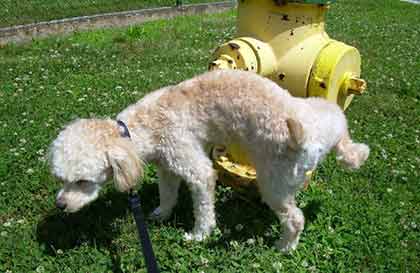Proteinuria in Pets

Proteinuria in Pets
When your pet has an annual physical examination, your veterinarian will often request a urine sample. Once you collect the sample, your veterinarian will have the urine analyzed in the laboratory. Urinalysis is a test which assesses nearly 20 different parameters. This blog post will focus on one particular parameter of the urinalysis, protein.
Protein is Not Normal
In a normal dog or cat, very little protein passes through the kidneys and into the urine. When a routine urinalysis identifies an increase in urine protein, a number of tests are performed to determine the source of the protein. If the source is thought to be the kidneys, a follow-up test called a urine protein creatinine ratio is performed. This ratio helps us determine if the protein in the urine is elevated to a level where medical intervention is needed. Multiple assessments of a pet’s protein creatinine ratio may be necessary before a diagnosis of excessive protein in the urine is made. The condition where excessive protein is lost in the urine is called proteinuria.
Causes of Proteinuria
Chronic kidney disease is probably the most common cause of proteinuria, but veterinarians see it in pets with other chronic diseases as well. Diabetes, Lyme disease, and Cushing’s disease have all been associated with increased urine protein levels. But a bladder infection or fever might cause increased protein in the urine. The key to determining the cause of proteinuria is a complete diagnostic evaluation which will include blood tests, blood pressure measurement, and possibly even an ultrasound.
Protein is a Problem
Proteinuria is problematic on several levels. Protein in the urine signals a problem with the kidneys. The leakage of protein though the kidneys damages the kidneys and decreases their ability to remove waste products from the body, leading to kidney failure. Loss of protein in the urine can deplete the protein in the body, putting the patient at risk for swelling of the limbs and blood clots. High blood pressure has also been associated with protein loss in the urine. In both dogs and cats with chronic kidney disease, proteinuria correlates with an increased risk of death from chronic kidney disease when compared to patients without proteinuria.
Treating Proteinuria
Once a diagnosis of proteinuria has been established, any underlying disorders, such as Lyme disease, will be treated. Successful treatment can resolve the proteinuria. If the cause of the proteinuria is chronic kidney disease, then lifelong treatment will be required. Non-drug interventions include a kidney-friendly diet and anti-inflammatory supplements like fish oil. Angiotensin converting enzyme (ACE) inhibitors like enalapril or benazepril, and newer medications like telmisartan (an angiotensive receptor II blocker) are administered to decrease protein loss. If pets have high blood pressure, antihypertensive medications will be prescribed and blood pressure monitored. Some pets with serious protein loss need medications to prevent formation of blood clots.
Help Keep Your Pet Healthy
You are part of your pet’s healthcare team. Your efforts in collecting a urine sample helps veterinarians like me take better care of your pet. Better care means you and your pet can have more healthy and happy years together.

































